Lenovo ThinkStation D30 Workstation Review: 16 Cores and 32 Threads Under Your Desk
by Dustin Sklavos on November 15, 2012 12:01 AM EST- Posted in
- Systems
- Lenovo
- Quadro
- Workstation
- Sandy Bridge E
- Enterprise
- Octalcore
Application and Futuremark Performance
On paper, the Lenovo ThinkStation D30 I have in for review is the fastest desktop I've ever tested and should easily best the other workstations I'll be comparing it to. The Quadro 5000 is the most powerful workstation GPU (up to this point I've only tested the 4000) on the charts, and dual Intel octalcore Xeons should give any system a run for their money. At the same time, keep in mind that the PCMarks are extremely dependent on storage subsystem performance, and I get the distinct impression that's going to be the achilles' heel of this review system due to the mechanical hard disk.
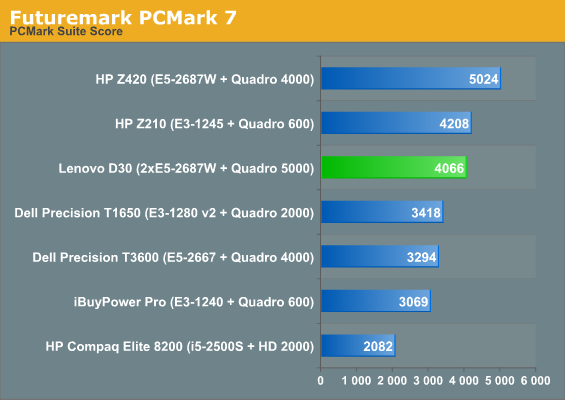

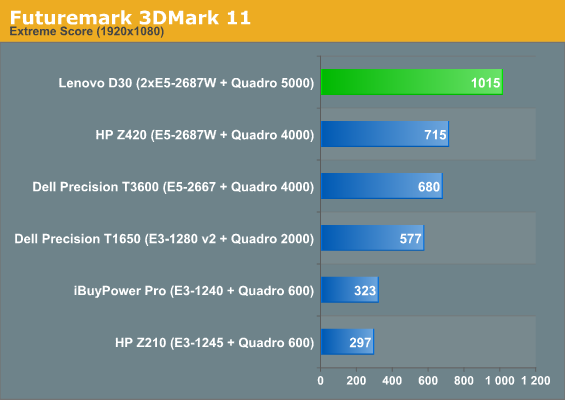
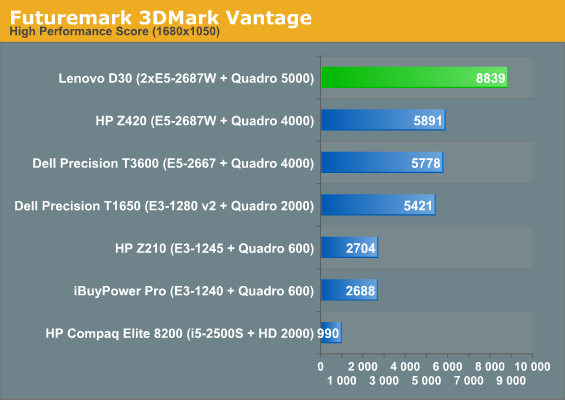
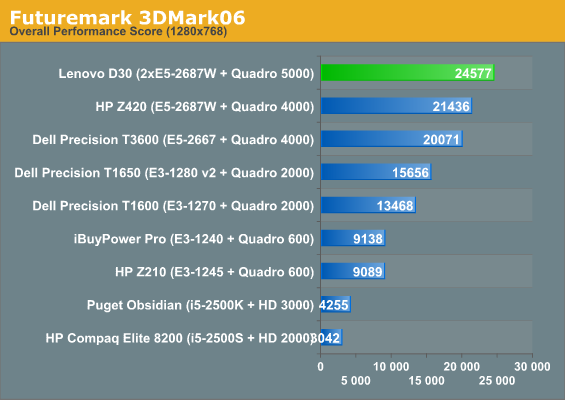
The 3DMarks defer to the Quadro 5000 as they should, but the two HP workstations both enjoyed SSDs as their system drives instead of the mechanical drive in the D30, and even eight more 3.1GHz cores can't really pick up the slack.
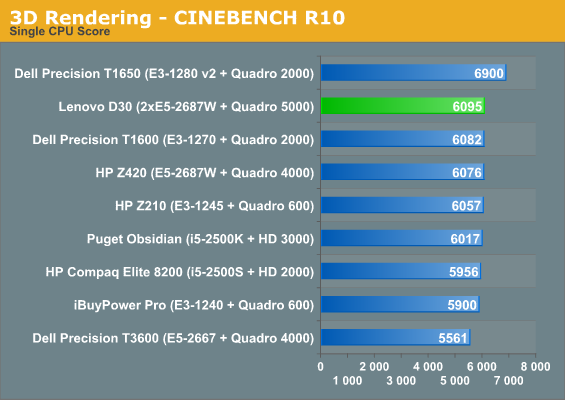

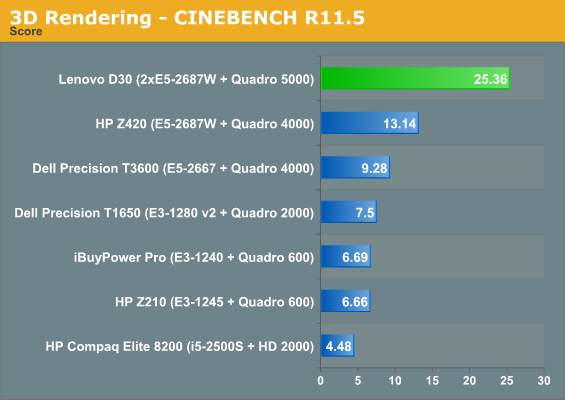
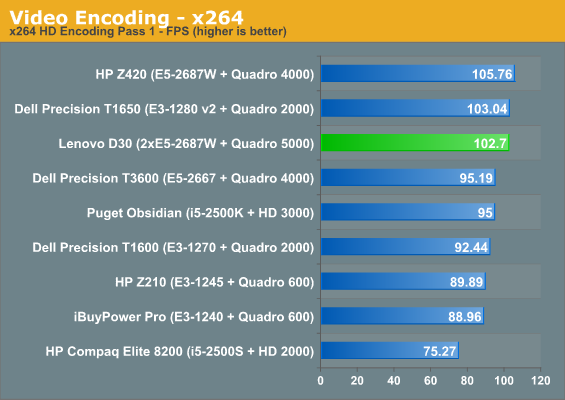
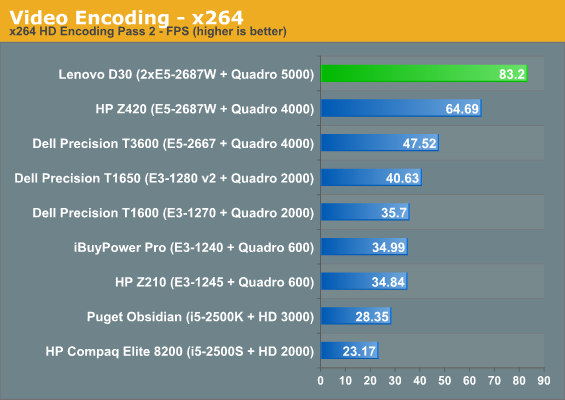
Pushing single-threaded applications is an absolute waste of the hardware in the D30, but the instant anything multi-threaded comes in the extra eight cores come on line and the system surges ahead. What I find most interesting, though, are the x264 results. Despite having half the CPU power, the HP Z420 is able to actually beat the D30 in the first pass by three frames. In the second pass, the extra eight cores in the D30 only offer a roughly 33% boost in performance.
Suspecting the storage subsystem was holding the D30 back, I grabbed a spare 60GB OCZ Vertex 3 I had laying around and plugged it in, then ran the x264 benchmark off of it. The results were actually very surprising, and in retrospect I may have been too hard on Lenovo for their decision, as the D30 crunched through the video in roughly the same amount of time.










68 Comments
View All Comments
colonelciller - Thursday, November 15, 2012 - link
Let's have a review of a true powerhouse from BOXXi have a feeling that a high end workstation from BOXXwould put other big name manufacturers to shame
http://www.boxxtech.com/
just4U - Thursday, November 15, 2012 - link
They'd have to send in a review sample..theduckofdeath - Thursday, November 15, 2012 - link
" That's not a knife. This is a knife."http://www.elnexus.com/products.aspx?line_id=15689
kkwst2 - Thursday, November 15, 2012 - link
Umm, no. They're basically more overpriced than Lenovo for essentially the same hardware. Why do you think it would be significantly faster?When I'm shelling out that much money for a workstation I stick with HP, Lenovo, or Dell. I've gone with smaller vendors before and their support level just isn't there. Dell workstation support is actually pretty good, as opposed to their crappy consumer support.
afkrotch - Wednesday, November 21, 2012 - link
Dell's Enterprise Gold Support is fabulouscreed3020 - Thursday, November 15, 2012 - link
Thanks for the review of another enterprise workstation. I really appreciate keeping up with what this market to has. Having worked a previous company that was in bed with HP it is nice to see what the other big guys are up to.I totally agree about the wiring nightmare. I can give this an F- for wiring, especially at this price point! I would expect, yes expect, a very clean system inside to maintain airflow, remove extra surface area for dust to collect, and to make system maintenance/hardware upgrades painless. The inside of this case looks like a system that someone just learning how to assemble PCs for the first time.
A government entity I recently worked with had procured this same chassis with a slightly different configuration and I was confused at the lack of redundancy within the storage tier of the solution. A single 150GB WD Raptor drove the solution. The lack of RAID 1 really surprised me considering the reduction in potential downtime this simple addition could make. There are clearly many single points of failure within this system, I'm not saying this machine needs dual PSUs. etc, but a little more value in the storage tier would make this compute crunch look that much more like a contender.
Last thought, 2GB ECC modules are direct cheap and moving to a higher density 4GB module seems like a no brainer to hit the entry mark of 16GB of RAM. I really hate it when OEMs take this route with a brand new machine. It just screams cheap.
kkwst2 - Thursday, November 15, 2012 - link
There is a performance hit for going RAID 1 unless you have a really good hardware solution. You're generally better off with a separate hardware RAID solution for your data and keep the RAPTOR or SSD as a single drive. Especially with an SSD, failure is very unusual. Just keeping weekly backups of the system is sufficient for me. If you really can't tolerate downtime, you're better off cloning the drive periodically than going RAID1. RAID1 is to prevent data loss, not prevent downtime. You're going to have downtime while you rebuild the array anyway.I do all my compute on an SSD and then have an external SAS storage box attached to a good hardware RAID controller in RAID10 to store all my input/output files.
Taft12 - Friday, November 16, 2012 - link
"RAID1 is to prevent data loss, not prevent downtime. You're going to have downtime while you rebuild the array anyway."For someone using such awesome hardware, I don't know how you got this exactly backwards. RAID1 is not going to save you from deleting the wrong directory or mirroring OS corruption. It *WILL* allow the system to keep running when one of the drives fails, and even terrible software RAID won't force downtime while you rebuild the array, where did you get that notion from?
kkwst2 - Sunday, November 18, 2012 - link
With respect, I didn't get anything backwards. The comment about deleting a file is silly and irrelevant. No RAID mode will prevent human error.RAID1 prevents data loss from a single drive failure. That is what it is for. So for me, from experience, my compute performance is degraded 5x during a RAID rebuild.
So I switched to having a cloned drive, which will get me back to full performance very quickly. I'll lose the last compute job I was working on, but that is usually not a big deal. I stand by my recommendation.
edlee - Thursday, November 15, 2012 - link
I have a thinkserver ts130 at home, and I have to agree that the cabling is less stellar than my dell poweredge servers in the office, but lenovo has much superior quality caps than the dells.I am constantly getting service requests to swap out motherboards on the dells, due to one small component getting fried. I know its not the power, because we have line conditioners smoothing out the voltage.
If you want less hassles in life, buy lenovo servers and workstations.